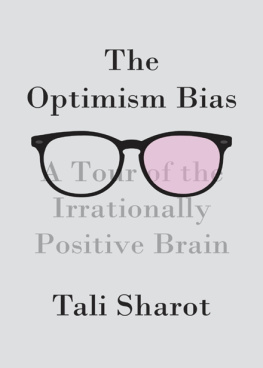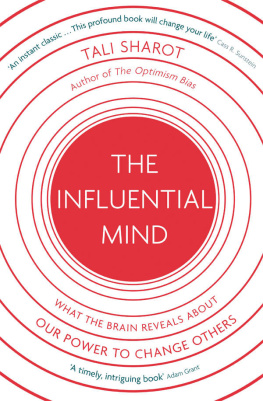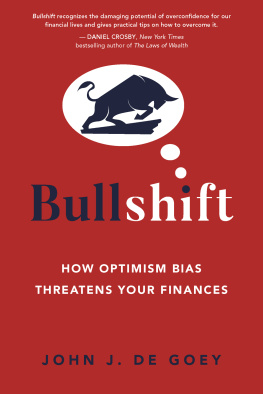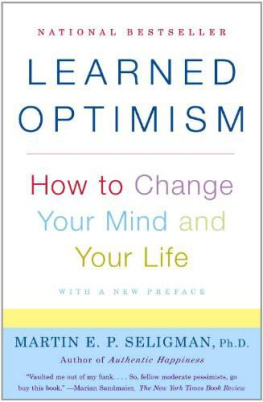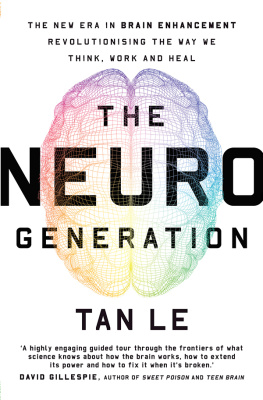Tali Sharot - The Optimism Bias: A Tour of the Irrationally Positive Brain
Here you can read online Tali Sharot - The Optimism Bias: A Tour of the Irrationally Positive Brain full text of the book (entire story) in english for free. Download pdf and epub, get meaning, cover and reviews about this ebook. year: 2011, publisher: Pantheon, genre: Religion. Description of the work, (preface) as well as reviews are available. Best literature library LitArk.com created for fans of good reading and offers a wide selection of genres:
Romance novel
Science fiction
Adventure
Detective
Science
History
Home and family
Prose
Art
Politics
Computer
Non-fiction
Religion
Business
Children
Humor
Choose a favorite category and find really read worthwhile books. Enjoy immersion in the world of imagination, feel the emotions of the characters or learn something new for yourself, make an fascinating discovery.
- Book:The Optimism Bias: A Tour of the Irrationally Positive Brain
- Author:
- Publisher:Pantheon
- Genre:
- Year:2011
- Rating:3 / 5
- Favourites:Add to favourites
- Your mark:
- 60
- 1
- 2
- 3
- 4
- 5
The Optimism Bias: A Tour of the Irrationally Positive Brain: summary, description and annotation
We offer to read an annotation, description, summary or preface (depends on what the author of the book "The Optimism Bias: A Tour of the Irrationally Positive Brain" wrote himself). If you haven't found the necessary information about the book — write in the comments, we will try to find it.
Tali Sharot: author's other books
Who wrote The Optimism Bias: A Tour of the Irrationally Positive Brain? Find out the surname, the name of the author of the book and a list of all author's works by series.
The Optimism Bias: A Tour of the Irrationally Positive Brain — read online for free the complete book (whole text) full work
Below is the text of the book, divided by pages. System saving the place of the last page read, allows you to conveniently read the book "The Optimism Bias: A Tour of the Irrationally Positive Brain" online for free, without having to search again every time where you left off. Put a bookmark, and you can go to the page where you finished reading at any time.
Font size:
Interval:
Bookmark:
I am extremely fortunate to have kind, talented, and intelligent friends who also happen to be my colleagues. They not only enhanced the quality of this book by reading chapters, making comments, and offering suggestions, but also provided cheerful support, rendering the process more enjoyable. Tamara Shiner patiently read every single word I wrote and listened to all my dilemmas, of which I had many. She took on the role of friend, collaborator, therapist, and physician. I am eternally grateful. Amir Doron, an author of a brilliant series of books for teenagers, helped me navigate through the early stages of The Optimism Bias. Amir is a walking, breathing Google search engine who contributed ideas to many of the examples in this book. I am thankful for taking that empty seat beside him many years ago at our first undergraduate economics lecture. The extraordinary Rosalyn Morn provided help with everything from program code to graceful solutions to social and professional conflicts. Sara Bengtsson gave particularly insightful advice after reading this book; her innovative work inspired news items and provided commentary. Special thanks to Steve Fleming, whose stubborn support throughout this adventure made me optimistically biased. Our frequent interactions keep challenging my thought and improving my science.
I am especially grateful to my mentor, Elizabeth Phelps. Liz is not only a renowned scientist but also an exceptional woman and adviser. I dread to think where I would be had I not stumbled unannounced into her office more than a decade ago. I owe to her my passion for neuroscience and the constant aim of conducting meaningful research. Liz introduced me to Ray Dolan, one of the leading cognitive neuroscientists working today, who was kind enough to take me under his wing. I am thankful to Ray for being a helpful mentor and close collaborator, and for offering me a spot at the Wellcome Trust Centre for Neuroimaging at University College London. Most of the research described in this book was conducted while I was there. One cannot envision a more dynamic and fruitful place. It is truly a unique institution that gathers together the most gifted and thoughtful scientists.
The idea of turning my research on optimism into a book came from Richard T. Kelly. Richard approached Kevin Conroy Scott from Tibor Jones & Associates, who later became my agent. I thank them both deeply for initiating The Optimism Bias and helping to make it into a book. Thanks also to Sophie Lambert and Marika Lysandrou from Tibor Jones. I am especially indebted to Dan Frank, my editor at Pantheon Books, who put his faith in The Optimism Bias at the exact time the financial markets were collapsing. I was fortunate to have such an insightful editor as Dan, whose experience and calm demeanor gave me great confidence. Thanks also to the patient Jillian Verrillo from Pantheon Books and to my editor at Knopf Canada, Diane Martin, who was optimistic from the get-go.
I owe my students recognition and gratitude for their hard work. Christoph Korn in particular made a large contribution to the research described in this book, as did Cristina Velasquez, Candace Raio, Alison Riccardi, Arshneel Kochar, Annemarie Brown, David Johnson, Katelyn Gulbransen, and Elizabeth Martorella. I would also like to acknowledge the numerous scientists whose work is described here, especially Karl Friston, Daniel Gilbert, Daniel Kahneman, Eleanor Maguire, Nicky Clayton, and Laurie Santos. Thanks to the British Academy for supporting my research and to my collaborators Benedetto De Martino, Yadin Dudai, Mauricio Delgado, and Andrew Yonelinas.
Finally, a huge thank-you to the other important people in my life, who, with the exception of one, are not neuroscientists: My friends Keren Sarbero Sorek and Maya Margi for their insight and support. My father, who inspired me to become an academic and whose ideas contributed to
Tali Sharot has a Ph.D. in psychology and neuroscience from New York University. She is currently a research fellow at the Wellcome Trust Centre for Neuroimaging at University College London. Her research on optimism, memory, and emotion has been featured in leading scholarly journals and media outlets, including Newsweek, the BBC, The Washington Post, The Boston Globe, The Wall Street Journal, Time, New Scientist, Nature, Science, and many others.
January 3, 2004, Sharm el-Sheikh. One hundred and forty-eight passengers and crew board Flash Airlines Flight 604 bound for Paris via Cairo. The Boeing 737-300 takes off at exactly 4:44 a.m. Two minutes later, it disappears from the radar.
Sharm el-Sheikh is located on the southern tip of the Sinai Peninsula. It is a tourist destination because of its year-round warm weather, beautiful beaches, and marvelous snorkeling and diving. The majority of passengers on Flight 604 are French tourists escaping the European winter to spend their Christmas vacation near the Red Sea. Entire families are on board Flight 604, on their way back home.
The crew is largely Egyptian. The pilot, Khadr Abdullah, is a decorated war hero, because of his performance flying the MiG-21 in the Egyptian air force during the Yom Kippur War. He has 7,444 flying hours under his belt, although only 474 of those are on the Boeing 737 he is piloting on this day.
According to its designated route, the aircraft should have ascended for a short while after takeoff and then turned left, heading toward Cairo. Instead, less than a minute into the flight, the plane turns right and quickly assumes a dangerous angle. Flying completely on its side, the jet begins spiraling downward Flight 604 crashes into the water moments after takeoff. There are no survivors.
At first, the authorities suspect a bomb had been planted on the plane by terrorists. This hypothesis arises because no distress signal was sent from the aircraft. However, when the sun comes up and pieces of the jet are discovered, it becomes apparent this theory is wrong. The pieces of the plane are detected close together, and there are not many of them. This suggests that when the plane hit the water, it was intact, rather than having exploded in midair, which would have resulted in many fragments scattering across the sea. What, then, caused Flight 604 to drop violently from the sky?
For the mystery to be solved, it is essential that the planes black box be found. The area of the sea where the plane crashed is one thousand meters deep, which makes it difficult to detect the signals emitted from the box. Furthermore, the black boxs battery will last for only thirty days; after that, the probability of finding it will be, realistically, nil. Egyptian, French, and U.S. search teams participate in the effort. Luckily, two weeks into the search, the black box is detected by a French ship.
The information from both the data recorder and the voice cockpit log contain clues that guide the investigators in a number of different directions. No less than fifty different scenarios are identified, then ruled out one by one, on the basis of the available data. No evidence of any airplane-related malfunction or failure can be found.
During spatial disorientation, also known as vertigo, a pilot is unable to detect the position of the aircraft relative to the ground. This usually happens when no visual cues are available, such as when the plane is flying in a dense cloud or in pitch-darkness over the ocean. The pilot may be convinced that he is flying straight when, in fact, the plane is in a banked turn, or when coming out of a level turn, he may feel he is diving. Trying to correct the (false) position of the aircraft only makes matters worse. During a rapid deceleration, a pilot sometimes feels the plane is facing downward. To rectify this illusion, the pilot may then pull up the nose of the plane, which often leads the aircraft to fall into a catastrophic spin known, for obvious reasons, as the graveyard spin. The graveyard spin is what seems to have happened to the Piper plane piloted by John F. Kennedy, Jr. It crashed into the Atlantic Ocean on July 16, 1999, after Kennedy suffered spatial disorientation while flying at night in bad weather en route to Marthas Vineyard.
Font size:
Interval:
Bookmark:
Similar books «The Optimism Bias: A Tour of the Irrationally Positive Brain»
Look at similar books to The Optimism Bias: A Tour of the Irrationally Positive Brain. We have selected literature similar in name and meaning in the hope of providing readers with more options to find new, interesting, not yet read works.
Discussion, reviews of the book The Optimism Bias: A Tour of the Irrationally Positive Brain and just readers' own opinions. Leave your comments, write what you think about the work, its meaning or the main characters. Specify what exactly you liked and what you didn't like, and why you think so.

